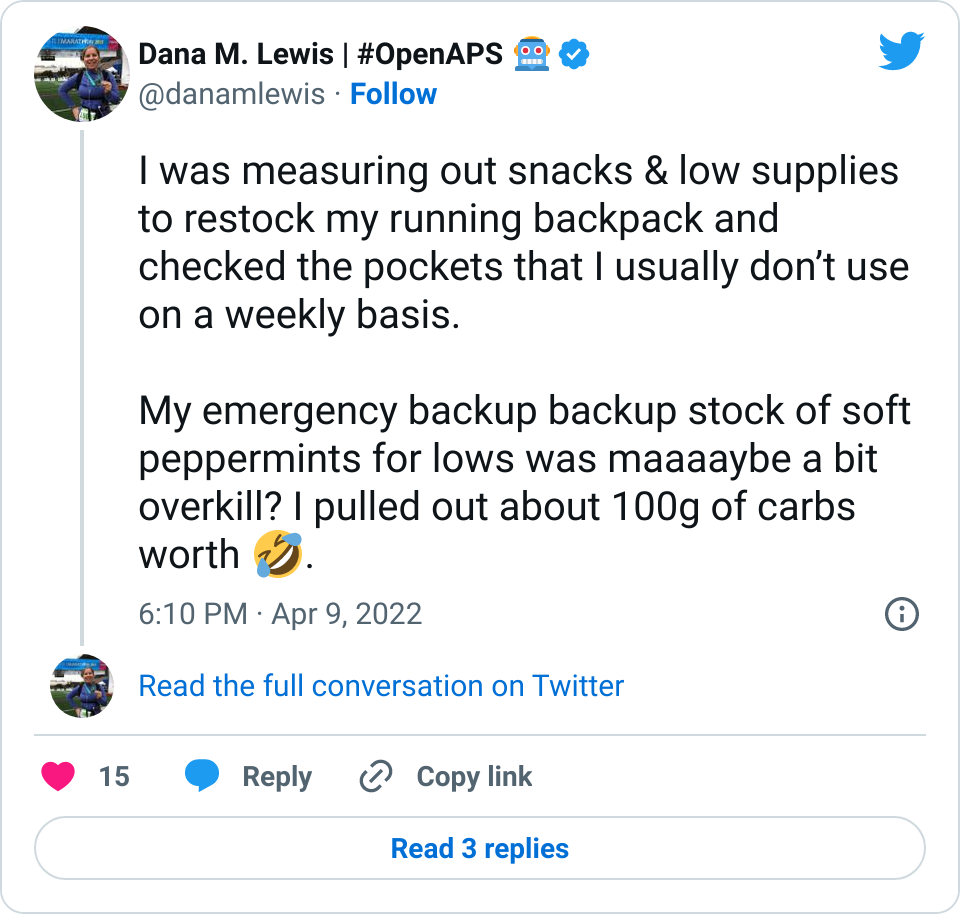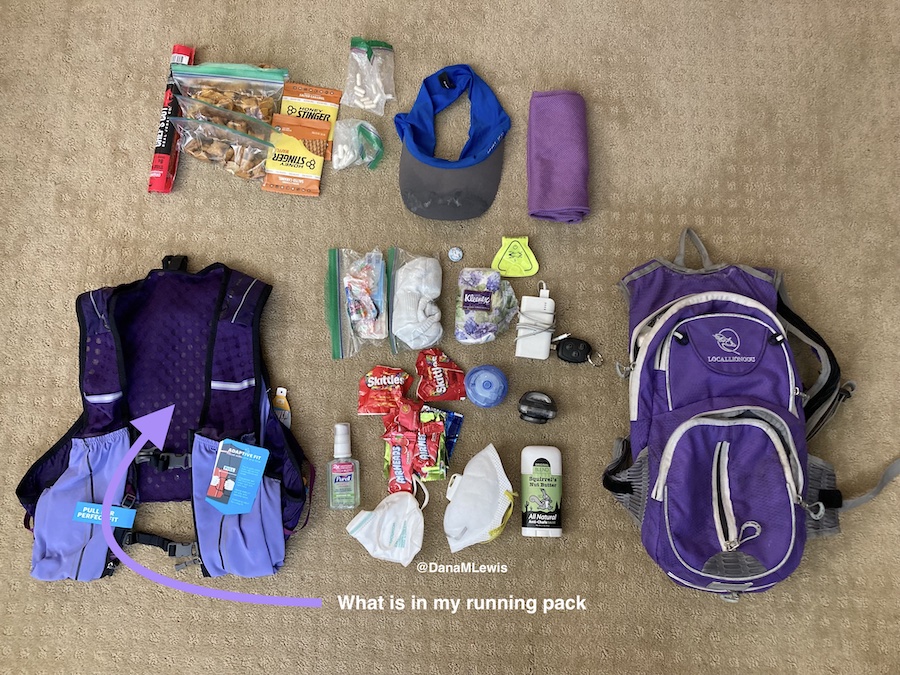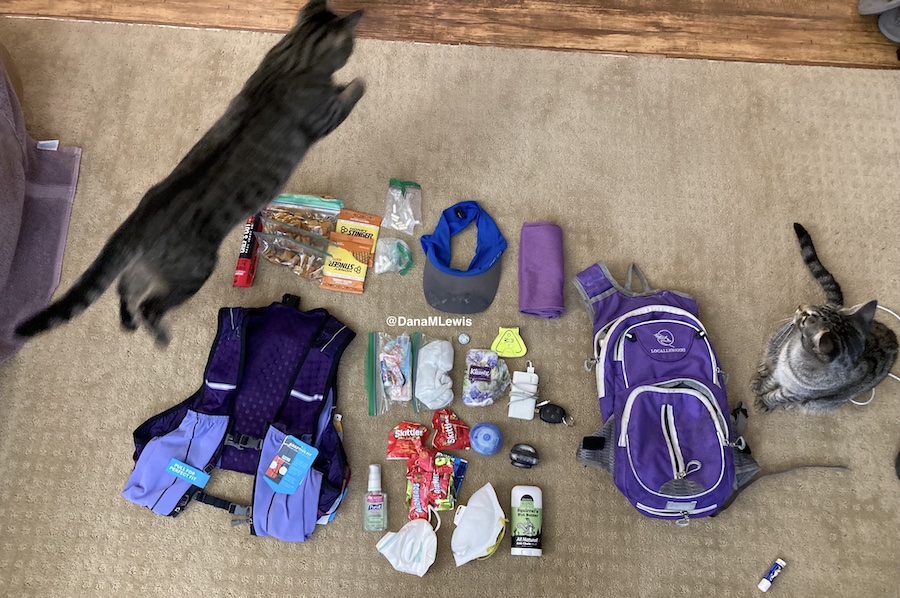After three years of using a multi-purpose activity backpack as my running pack, the strap connector broke, and I had to find and re-stock a new running pack. I use a running pack for when I’m doing long runs for marathon or ultramarathon training. I ended up pulling everything out of my old backpack and evaluating whether I still wanted to carry it on every long run. For the most part, everything got moved over to the new pack. There were a few cases where I had excessive duplicates (more on that below and why) where I ended up reducing the quantity. But everything else made the list for what I carry with me on long runs every single time.
- Hydration – via a camelbak or other bladder with a hose (example). I prefer straight water in my hydration pack and to separately manage electrolytes and fuel separately. The bonus of just having water is it’s easier to clean the hydration pack after each run!Tips: put ice cubes in your bladder and fill it with cold water. Cold water is awesome for long, hot runs in the sun. Also, my old hydration pack had an insulated compartment that kept the ice water cold for hours. My new running vest does not, and in fact has holes in the back for air flow that also means the heat from my back melts my ice pretty fast. To work around this in the new vest is to slide the filled hydration bladder into a padded mailing envelope that’s open at the top. It’s not quite as insulated as true insulation, but it protects the bladder from some of the heat coming off of your back and it probably stays cool 60% instead of 20% as long as before, which is a huge improvement.Extra tip: use a Qtip or similar to clean out the mouthpiece of your hose every few runs!
- Diabetes backups – this means things like a backup insulin pump site. On long unsupported runs, it can also mean my blood glucose meter. (I wear a CGM so I don’t always take a meter along on runs unless it’s in an unsupported area where I don’t have easy crew access or support within a few miles). I’ve had several runs where my pump site has stopped working or ripped out, so having a backup pump site is just as necessary as having bandaids.The other source of backups is extra low carbs, e.g. sugar in case my blood sugar goes low. I usually keep a stash of carbs in my shorts pocket, but I also keep extra in my backpack in case I run through everything in my pocket. This is in addition to regular food/fuel for ultrafueling, it has to be faster-acting glucose/sugar that can more quickly fix a dropping or already-low blood sugar level.(This is one of the places I mentioned where I had excessive duplicates. I have continued to add extra to my backup stashes, and ended up with well over 100+ grams of “backup” carbs just in case. I ended up cutting down the total amount of carbs to closer to ~50 grams instead.)

You can read some more about my strategy for running with diabetes here.
- Baggie with extra socks – I always carry a pair of extra socks, although I’ve never needed them in a normal training long run, I did end up using them in my 50k that involved crossing a river up to my knees five times.
- Bandaids – Just like hiking, but I carry bandaids in case of bleeding cuts or scratches or worse, blisters on my heels, feet, or toes. I carry some that are blister-style and some regular style, smaller ones and larger ones, all the way up to large multi-inch squares that can cover the backs of my heels if I don’t already have them covered.More recently, I also started carrying small squares and strips of kinesiology tape for the same purpose. I originally did kinesio tape strips in case my knee needed some extra support, but I’ve found the kinesio tape also works well to cover my toes or backs of my heels in lieu of bandaids for blister prevention. For fixing blisters, I have to dry my feet really well or the kinesio tape doesn’t stay well or easily rubs off; so I tend to cover the toes that blister frequently as well as my heels prior to my runs so they’re less likely to generate blisters and require fixing mid-runs. I get a large roll of kinesiology tape (example) and cut it into smaller pieces as needed for all of these uses cases.I also keep at least one mini individual packet of antibiotic ointment (example) in the baggie as well.
- Lubrication – I carry a lubrication stick (Squirrel Nut Butter, because it works for me and is easy to reapply) to making sure between my thighs and other areas don’t chafe. When I sweat a lot, I often have to reapply every few hours to my thighs. While this can also be accomplished by carrying dabs of vaseline or your preferred lubrication in a baggie, the SNB stick is lightweight and I don’t mind carrying it so it’s easy to reapply and the hassle doesn’t prevent me from wanting to prevent chafing.
- Stuff to fix GI problems – it’s common to have GI issues when running, but I also had a two-year stretch of known GI issues that ultimately turned out to be undiscovered exocrine pancreatic insufficiency. During this time, I always carried individual Immodium and GasX in case I needed them.
- Electrolyte pills – I prefer to measure and track electrolytes separate from my hydration, so I use electrolyte pills (example) that I swallow on a scheduled basis to keep my electrolyte levels topped off. I’ve tried chew kinds (but they make me burp), so I stick with a baggie full of electrolyte pills. I bring extra just in case I drop some, but I generally eyeball and count out to make sure I have enough for each super long run.
- Any medication you need during the run – For me, that includes enzymes for fuel because I have exocrine pancreatic insufficiency and I need enzymes to help me digest any of my fuel. I have expensive, larger dose prescription pills that I usually use for meals, but it would make running even more expensive if I had to use a $9 pill every 30 minutes for a fuel snack. Luckily, there are over the counter versions of enzyme pills (more about that here) that are single-enzyme or multi-enzyme, that are more in the ballpark of $0.35 per pill, and I have a baggie of both kinds that I use to cover each snack.
- Fuel or snacks – A lot of ultra runners use gels, but I have been experimenting with ‘real’ foods. Basically, anything that’s around ~20g of carbs and less than ~10g of fat and 5-10g of protein that I like to eat. So far, that list includes chili Cheese Fritos, yogurt covered pretzels, peanut butter pretzel nuggets, beef sticks, Honey Stinger Stroopwaffles (the gluten free kinds – beware that only some of their flavors are GF!), mini date or fruit bars, fruit snacks, sweet potato tots, ¼ of a ham and cheese quesadilla, ¼ of a PBJ sandwich, a waffle, mini PayDay bars…. Noting that all of these are gluten free versions or are naturally gluten free, because I have celiac disease. I do a lot of work in advance to test these snacks carefully on training runs before I commit to using them repeatedly throughout longer runs so I know my body likes them during runs as well as other times. I only take the fresh/hot snacks (sweet potato tots, quesadilla etc) and eat those at the start or when my husband re-fills my pack for me mid-run, so I don’t have to worry about them spoiling. Everything else is shelf stable so when I pack a few more than I need per run and leave some in my pack, they’re not an issue to sit there for weeks until I manage to eat them in my rotation of snacks on a future run.
- Miscellaneous other supplies – car keys, house keys, hand sanitizer, a mask for going into trail bathrooms, and a battery and cord for charging my phone.
Phew. That’s a lot of stuff. And yes, it does end up being more supplies and more weight than most people carry. But…I use pretty much everything in my pack every few runs. Stuff happens: pump sites fall out, blisters happen, chafing happens, GI stuff happens..and I’ve found that training and running with a little extra weight in my pack is worth having the proper supplies when I need them, rather than having to end runs early due to lack of preparation or minor supplies that would enable me to keep running.
Every time I go out for a run, I add the requisite amount of snacks, enzymes, electrolyte pills, and hydration for the run. Any time I come back from a run and I have depleted a supply off of the above list – such as using my backup pump site – I immediately go and refill that supply so I don’t have to remember to refill it prior to the next run. Keeping the above supplies topped off and ready to go always in my backpack means they’re always there when I need them, and the peace of mind of knowing how I can handle and that I can handle these situations while running is priceless.
Note: previously I was using a backpack, because it was $30 and for my running it was good enough. However, when the strap broke, I looked to buy the same backpack again and it was $60. It was fine for $30 but if I was going to double the cost, I decided to research alternative running packs and vests. Vests seem to be more common in ultrarunners, so I looked for those, although they’re a lot more expensive (often $125-200). I was disappointed with how small of a volume some of them held, or they were just ugly. I liked the look of a purple one I found that came with a 1.5L bladder….but ugh. I fit a 3L bladder in my previous backpack and typically fill it 2-2.5L full as a baseline, and all the way up for a longer (6h+) unsupported run. I decided to risk getting this vest even though it was smaller and try putting my larger 3L capacity bladder in the new vest. (Luckily it was on sale for $90 at the time which made it a little less annoying to buy compared to a $150 one.) The bladder does fit, but it sticks out the top and hits the back of my neck if it’s all the way full (3L). So for the most part, I’m filling the 3L capacity bladder about 2L full (and as noted in this post earlier, putting it inside an insulated envelope to help retain the cold for longer), and that works for me.
One thing I do like a lot from my new running vest is the front pockets. My old backpack I had to partially take off and twist around me in order to get snacks out. With two large front pockets, I can fit several hours of fuel in there so there is no twisting involved to get my fuel out, which is helping with my goal to fuel every 30 minutes. I do wish there was a separate smaller pouch – my old backpack had a small old school flip phone size “cell phone” pocket that I used to keep my baggies of enzymes and electrolytes in. Right now, I just have those baggies floating around the top of those pockets and it’s fairly easily to grab and pull out the right baggie, but I’m toying with adding some kind of small strap-on holster/pouch to the shoulder just for enzymes so I don’t have to worry as much about them jostling out when my pockets are completely full of snacks. But otherwise, these front pockets are overall a nice improvement.


